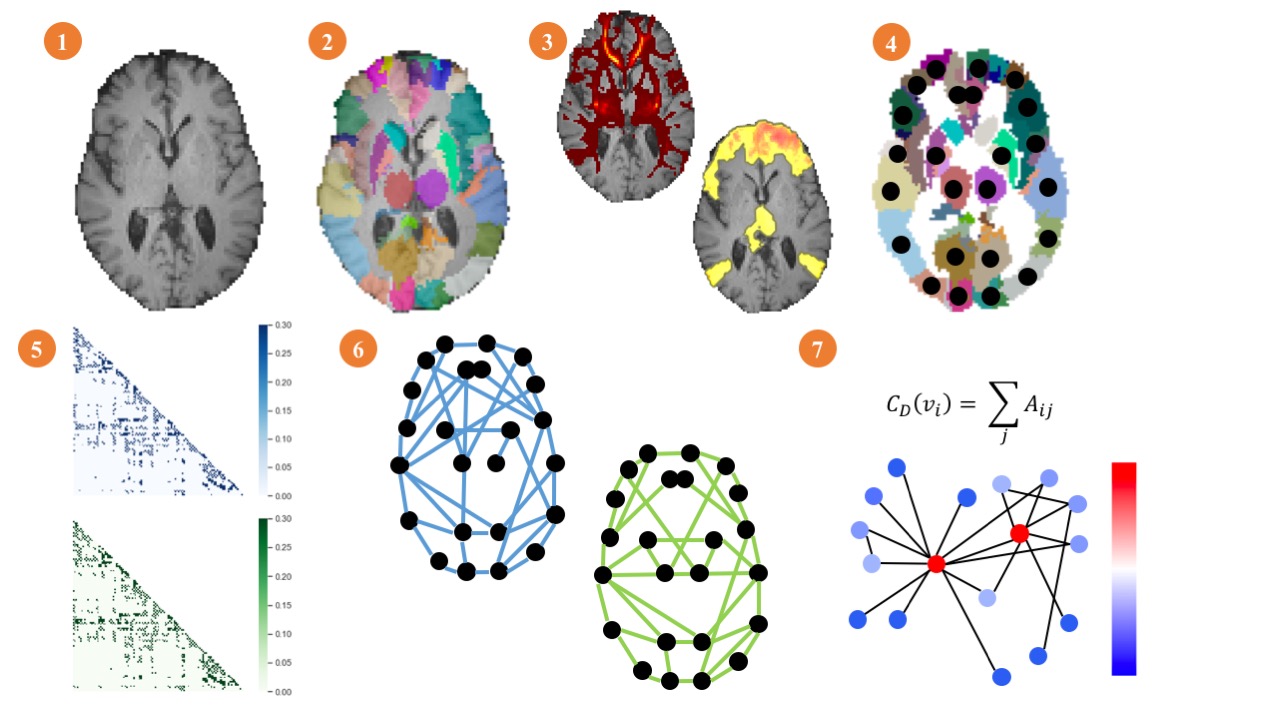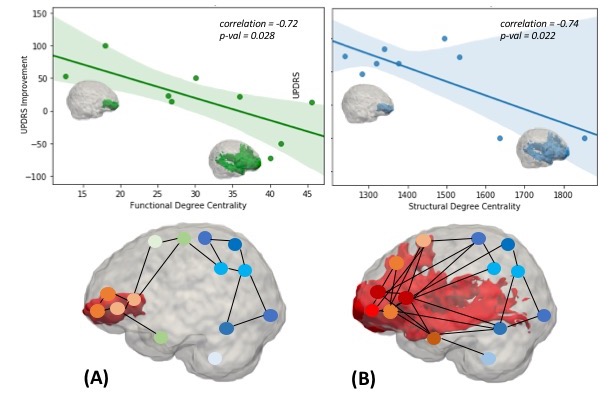Session Information
Date: Wednesday, September 25, 2019
Session Title: Neuroimaging
Session Time: 1:15pm-2:45pm
Location: Les Muses Terrace, Level 3
Objective: Identify structural and functional networks that may be used to predict motor improvement after deep brain stimulation (DBS), supporting the existence of an underlying anatomical substrate for functional networks.
Background: DBS targets the basal ganglia to treat motor symptoms in patients with advanced Parkinson’s Disease (PD), but is thought to have distributed network effects[CW1] .[1] The topology of white matter networks is crucial for efficient information integration between brain regions, and can be studied using advanced imaging techniques.[2] A breakdown of compensatory mechanisms influencing dopamine processing could contribute to PD, as striatal release of dopamine can signal a “reward prediction error”.[4][5] It has been suggested that functional connectivity to the ventromedial prefrontal cortex (vmPRFC) is crucial for the maintenance of cognitive function in patients with PD.[3]
Method: Diffusion-weighted and resting-state MRI scans were acquired in 9 patients with advanced PD undergoing DBS. Structural and functional correlation matrices were calculated between 120 regions defined by the Automated Anatomical Labeling (AAL) atlas. Network analysis was performed on both functional and structural matrices using the Graph-theoretical Network Analysis (GRETNA) toolbox. Hemibody MDS-UPDRS-III scores were correlated to ipsilateral and contralateral graph theory metrics for an evaluation of a total of 18 hemispheres. Correlations were tested for statistical significance using a one-tailed heteroscedastic t-test.
Results: Significant correlation was found between several functional graph theory metrics and percent improvement of MDS-UPDRS-III. There were significantly more functional than structural correlations between response to DBS and graph theory metrics overall. The vmPFC was significantly correlated to MDS-UPDRS-III improvement with degree centrality in both functional and structural networks (functional p=0.03, structural p=0.02) and was the only ROI showing significant correlation using both modalities.
Conclusion: These findings suggest that reward network integrity – particularly vmPFC connectivity – may help predict patient response to DBS in patients with advanced PD. Specifically, the inverse relationship (Fig 2A) suggests that candidates without the need for significant compensatory engagement of decision-making and reward networks may be better candidates for DBS therapy.
References: [1] Alhourani A, McDowell MM, Randazzo MJ, Wozny TA, Kondylis ED, Lipski WJ, Beck S, Karp JF, Ghuman AS, Richardson RM. Network effects of deep brain stimulation. Journal of neurophysiology. 2015 Aug 12;114(4):2105-17. [2] van den Heuvel, M. P., Mandl, R. C., Stam, C. J., Kahn, R. S., & Pol, H. E. H. (2010). Aberrant frontal and temporal complex network structure in schizophrenia: a graph theoretical analysis. Journal of Neuroscience, 30(47), 15915-15926. [3] Muthuraman M, Deuschl G, Koirala N, Riedel C, Volkmann J, Groppa S. Effects of DBS in parkinsonian patients depend on the structural integrity of frontal cortex. Scientific reports. 2017 Mar 6;7:43571. [4] Nandhagopal R, Kuramoto L, Schulzer M, Mak E, Cragg J, McKenzie J, McCormick S, Ruth TJ, Sossi V, De La Fuente-Fernandez R, Stoessl AJ. Longitudinal evolution of compensatory changes in striatal dopamine processing in Parkinson’s disease. Brain. 2011 Nov 1;134(11):3290-8. [5] Schultz W. Dopamine neurons and their role in reward mechanisms. Current opinion in neurobiology. 1997 Apr 1;7(2):191-7.
To cite this abstract in AMA style:
J. Muller, L. Li, C. Matias, M. Alizadeh, J. Miao, S. Thalheimer, V. Romo, F. Mohamed, C. Wu. Multimodal Graph Theory Analysis Identifies Reward Network in Prediction of Motor Response to Deep Brain Stimulation [abstract]. Mov Disord. 2019; 34 (suppl 2). https://www.mdsabstracts.org/abstract/multimodal-graph-theory-analysis-identifies-reward-network-in-prediction-of-motor-response-to-deep-brain-stimulation/. Accessed January 1, 2026.« Back to 2019 International Congress
MDS Abstracts - https://www.mdsabstracts.org/abstract/multimodal-graph-theory-analysis-identifies-reward-network-in-prediction-of-motor-response-to-deep-brain-stimulation/


